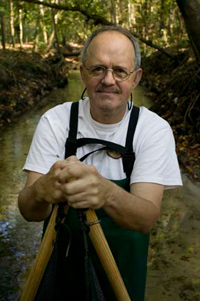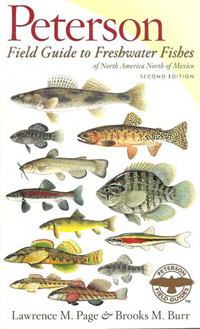While Florida Museum of Natural History ichthyologist Larry Page collected specimens in Thailand this spring, Houghton Mifflin Harcourt released one of his most significant publications, the second edition of the “Peterson Field Guide to Freshwater Fishes of North America North of Mexico.”

Florida Museum photo by Eric Zamora
“I use it myself all the time, believe it or not,” said Page, a curator at the museum located on the University of Florida campus. “We keep copies in every lab and every office because specimens come in all the time and we need it for our own research and work.”
Published in May, the guide includes 114 new native, 19 invasive and 16 non-native, or exotic species, with eight deleted from the first edition as invalid or non-established exotic species. The book also recognizes 16 species that have gone extinct in modern times. The 909 species increased from 768 in the first edition.
“The increase in number is really astonishing when you consider that we’re talking about a group of vertebrates in the U.S. and Canada, arguably the best-known parts of the world,” Page said. “People have a different way of thinking about species than they did when the field guide was first published in 1991.”
The field guide is organized by when fish appeared, from the most ancient to more recent species, and features new maps made possible by technological advances in geographic information system mapping that shows the geographic range of each species.
“It provides a good reference point to see how the ranges have either decreased or expanded over time,” said museum researcher Griffin Sheehy, who spent about five years creating the book’s nearly 600 color maps. “The old [first edition’s] maps didn’t even have water features.”

Photo by Eric Zamora
There are about 31,000 recognized fish species worldwide, and while only about 3 percent are native to the fresh waters of North America, the continent has the most diverse temperate freshwater fish fauna, Page said.
The first edition sold about 106,000 copies, possibly making it the highest-selling book ever published about fishes, Page said. He and co-author Brooks Burr are already thinking about what to add for a third edition, he said.
“Obviously, you write a field guide because people want it,” Page said. “Clearly a lot of people do care about what they’re catching, what they have in their aquarium and what they’re looking at in class.”
The book is part of a set that includes the “Peterson Field Guide to Atlantic Coast Fishes” and the “Peterson Field Guide to Pacific Coast Fishes.” Page said the book’s most useful feature, which many field guides do not include, is the “similar species” section at the end of every species’ account, which refers the reader to other species with physical similarities.
Bill Eschmeyer, who co-authored the “Peterson Field Guide to Pacific Coast Fishes,” said the field guides are mainly of interest to students, naturalists, conservationists and state fish and game employees. He analyzed the book page-by-page to enter new species into the “Catalog of Fishes,” which he maintains for the California Academy of Sciences in San Francisco.
“It’s extremely accurate and the drawings and maps are very good,” Eschmeyer said. “This edition includes a lot more species and better ranges.”
The 57 pages of specimen illustrations (known as plates) at the beginning of the book were drawn and painted by Eugene C. Beckham III, John Parker Sherrod, Justin T. Sipiorski and Joseph R. Tomelleri. The National Audubon Society, the National Wildlife Federation and the Roger Tory Peterson Institute sponsored the guide.
“I’ve published over 100 scientific papers, but because this field guide is used by so many people, I probably think this is the most important thing I’ve done,” Page said.
Learn more about the Ichthyology Collection at the Florida Museum.